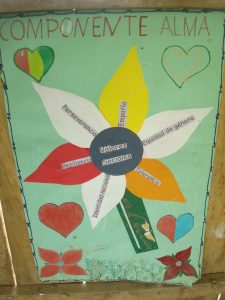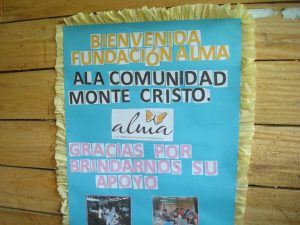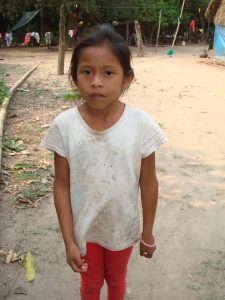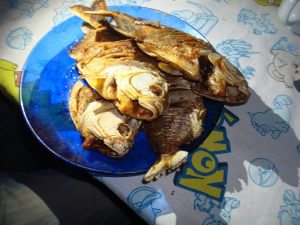
We set out from Trini at 3 AM in a pickup truck owned by the Municipality. Our group for this road trip is our project manager Kathe, our program director Ian, and two staff people from the Municipality – Raquel and the driver “El Chino”. One of the reasons we have had success here is that the Municipal government, in particular, the mayor is 100% supportive of our work. They take Kathe out regularly. This saves us a lot of money and shows the communities that the government is supportive of our work. The success we have had in educating kids in the communities then reflects well on the mayor – it’s a mutually beneficial relationship.
I’ve tried to describe the drive to the cluster of communities of Monte Cristo, Cotoca and Manguita many times but words can’t-do it justice. It is long (seven to eight hours), bumpy (the first two hours are on a “highway”, the last six along a dirt path crossing savannah and jungle) and is often washed out if there is any rain at all. When it’s wet the trucks inevitably go off the paths and we need to get them back on the path by pushing and pulling with ropes. We go over many very dicy narrow bridges and inevitably it’s an “adventure”. The scenery is nice though and we see lots of birds and other animals along the way. In the rainy season, Kathe goes by boat (13 hours) through some of the communities become completely inaccessible.
By the time we got to Monte Cristo I was ready for a shower. That wasn’t going to happen as there is no electricity or running water in any of our communities here. Instead, we sat in on the Alma class. In this community, we have a secondary school level program where students are creating social/economic projects. Along the way they are meeting State level math and language requirements, also they are learning the Alma curriculum around social and environmental values and critical thinking. This is our second year using computers here so students are still learning how to navigate their way around basic Microsoft office software as well.
The good news: the students love using the computers and are advancing well. Also, we were pleased to see that they had interviewed several parents to learn background on their projects. One group’s project, for example, is to grow corn so the students asked a number of parents and relatives about corn. Bringing parents into the education process and asking them about what they do, particularly the fathers, not only taps into the parent’s wisdom but integrates them into their children’s studies.

The bad news: the students didn’t really seem to understand their projects. It is early but when we asked some pretty basic questions about, say, the harvest of corn, they couldn’t answer them. I tried to use a SWOT analysis approach and they had a lot of trouble even coming up with risks to their projects. A theme emerged that we eventually witnessed in most of our projects: the teachers are not getting the students to ask critical questions enough. They are still copying without thinking, and reading without comprehending to the degree we want them to.
After our class visit, we had lunch. The only way that the communities can thank us is to feed us huge meals so we always get a very special meal – usually rice (which they grow here and is delicious), potatoes, fideo (a pasta) and some sort of meat – chicken, wild pig, or duck. Everything that they eat is grown or raised by them in their communities. The mothers cook the meals and serve us. It alwa
ys feels a little awkward for me because they don’t eat with us and the portions are huge and usually have a meat that they would only eat on very special occasions. For me, it is a lot of food but it is rude to not eat it and it does taste great. I notice that the others all eat every morsel and suck every last thread of meat off of the bones of whatever meat we are served. It is a matter of respecting the people who made our food and the animals who gave their lives for our food. The biggest difference between urban poverty and rural poverty is that in rural areas like this there is always food. There are wild animals and fish to hunt, fruit trees are in abundance and rice is easy to grow.
I avoid the drinks because they are based on contaminated river water but still, for a variety of reasons I always eventually get sick.
In the late afternoon, we met with the paren

ts to discuss the project. In these meetings, we discuss what we think is working and not but mostly we use this opportunity to get guidance from them on what they think is working and also to discuss how they are helping their kids in the home. Part of what our teachers do are home visits. The goal is to ensure that education is also happening in the home and that the kids’ homes are safe places. We ask the parents for examples of strategies they are using that they think are helping (partly to motivate the other parents to do the same). I usually get a lot of questions about our commitment to their communities because they seem to appreciate how challenging it is for teachers to live out here. I also always get a lot of “thank yous” and “God will bless yous”.
There will be a party in this village tonight (a girl turned 15). The parties here go until 5 AM and are usually a mess. Home-made beer and watered down rubbing alcohol (cheap and easy to get). It’s something that I want to have nothing to do with so Kathe and the municipal stayed to bond, while Ian and I decided to sleep in the next community.
Before we left they insisted on feeding us again. The men had gone fishing in the local lagoon. They walked into the water with fish line and hooks baited with raw meat. They came back with about 30 piranha fish that the Moms fried up for us. I asked them if they were afraid of standing in piranha-infested waters, fishing with raw meat and they gave me that “you soft white gringo“ look.

